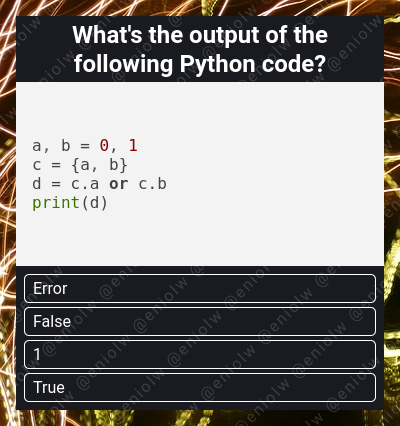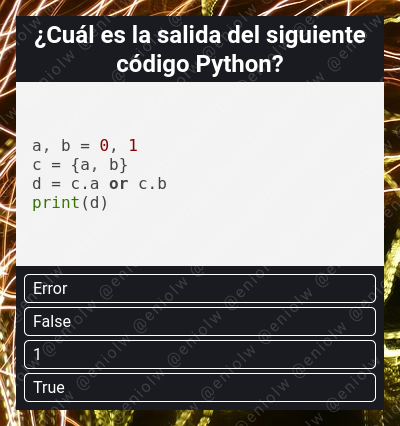My Coding Quiz #16
My Coding Quiz #16 👨💻🛠️🧩
Welcome to the new installment of my series of Coding Quizzes, in which you will be able to test your knowledge and skills about programming and software development in a simple and fun way. If you want to learn more about it visit my blog here on Hive and the first post where I introduced it.
Without further ado, here's the riddle...

By @eniolw
What's your choice?
Solution to the previous quiz: [[2], [5, 6]]. First a list w is created with three nested lists and we know that lists are mutable objects.
Then a copy x of w is made using the built-in copy method. This method creates a shallow copy of an object, so the sublists of w are not actually copied, but referenced. As a consequence, the new list x still has access to the elements of w, since it did not store copies of them, but rather references, so those elements can be modified by manipulating the list x.
So, line 3 applies the pop method to x[0], which is the sublist [2, 1]. We know that pop by default removes the final element and returns it, so from [2, 1] the value 1 is removed and assigned to y, leaving that sublist at [2] and the list x at [[2], [3, 4], [5, 6]]. The content of w was also affected by being the same as x, so it also has [[2], [3, 4], [5, 6]].
Line 4 again applies the pop method to w, but this time specifies in the argument to remove the element at position y, meaning, 1. From the list w, which consists of [[2], [3, 4], [5, 6]], the sublist [3, 4] is removed and then assigned to z, although the code does nothing with that variable. The final composition of w is [[2], [5, 6]] and is what is printed at the end.
If you want to blog about computer science and programming content, I invite you to join Hive and participate in its communities, such as STEM-social, Develop Spanish, Programming & Dev, Hive Learners and others.
Mi Quiz de Programación #16 👨💻🛠️🧩
Bienvenido a mi nueva serie de Quizzes de Programación, en la cual podrás poner a prueba tus conocimientos y habilidades sobre programación y desarrollo de software de una manera sencilla y divertida. Si quieres aprender más sobre ella visita mi blog aquí en Hive y el primer post donde la presenté.
Sin más preámbulos, he aquí el acertijo...

Por @eniolw
¿Cuál es tu elección?
Solución al quiz anterior: [[2], [5, 6]]
. Primero se crea una lista w con tres listas anidadas y sabemos que las listas son objetos mutables.
Luego se hace una copia x de w usando el método incorporado copy. Este método crea una copia poco profunda de un objeto, por lo que las sublistas de w no son realmente copiadas, sino referenciadas. Como consecuencia, la nueva lista x aun tiene acceso a los elementos de w, pues no guardó copias de ellos, sino referencias, por lo que esos elementos pueden ser modificados manipulando la lista x.
Entonces, la línea 3 aplica el método pop a x[0], que es la sublista [2, 1]. Sabemos que pop por defecto remueve el elemento final y lo retorna, por lo que de [2, 1] se remueve el valor 1 y se asigna a y, quedando esa sublista en [2] y la lista x en [[2], [3, 4], [5, 6]]. El contenido de w también se vio afectado por ser el mismo de x, por lo que también posee [[2], [3, 4], [5, 6]].
La línea 4 aplica nuevamente el método pop a w, pero esta vez se especifica en el argumento que se remueva el elemento en la posición y, es decir 1. De la lista w, que consiste en [[2], [3, 4], [5, 6]], se remueve la sublista [3, 4] y se asigna a z, aunque el código no hace nada con esa variable. La composición final de w queda en [[2], [5, 6]] y es lo impreso al final.
Si quieres bloguear sobre contenido informático y de programación, te invito a unirte a Hive y participar en sus comunidades, tales como STEM-social, Develop Spanish, Programming & Dev, Hive Learners y otras.
Saludos
Mi respuesta es:
Error
Sí, hay un error.
Looks quite easy but will be difficult
It's not difficult if you understand Python.
Thanks for your contribution to the STEMsocial community. Feel free to join us on discord to get to know the rest of us!
Please consider delegating to the @stemsocial account (85% of the curation rewards are returned).
You may also include @stemsocial as a beneficiary of the rewards of this post to get a stronger support.
error !
I think 'in' operator will be used to give the statement a Boolean result, True.